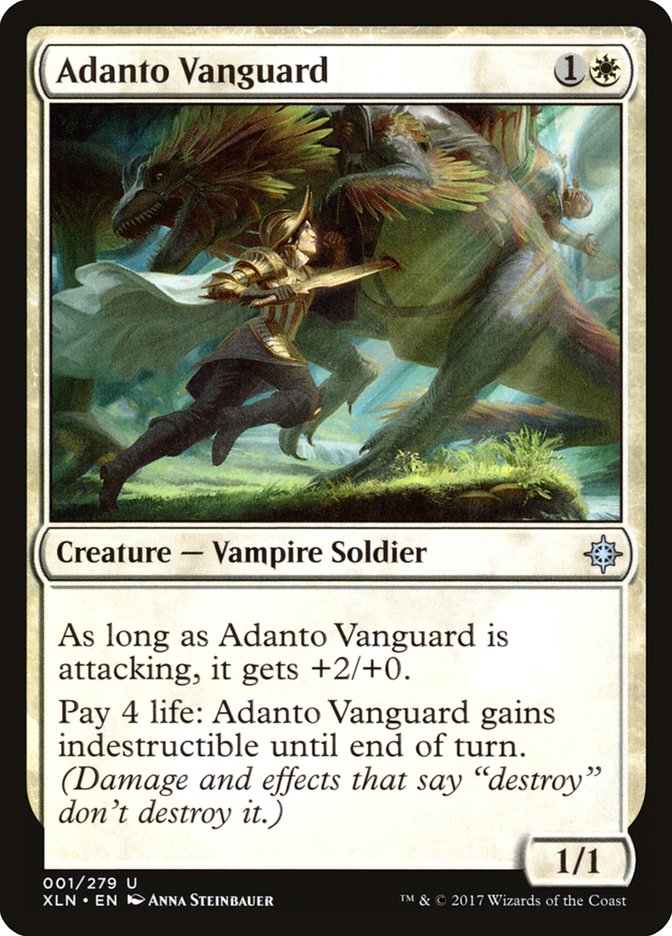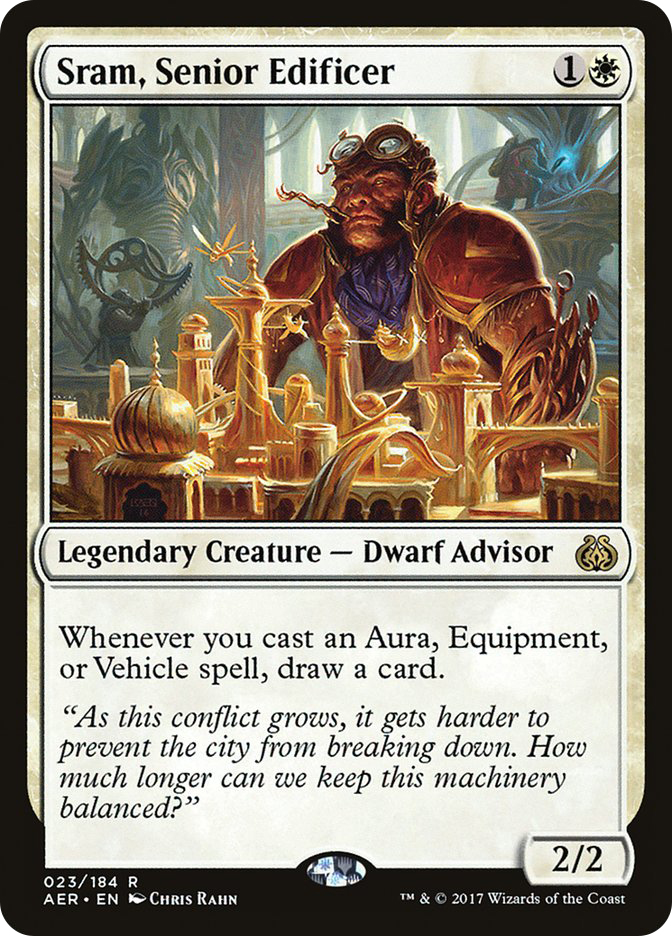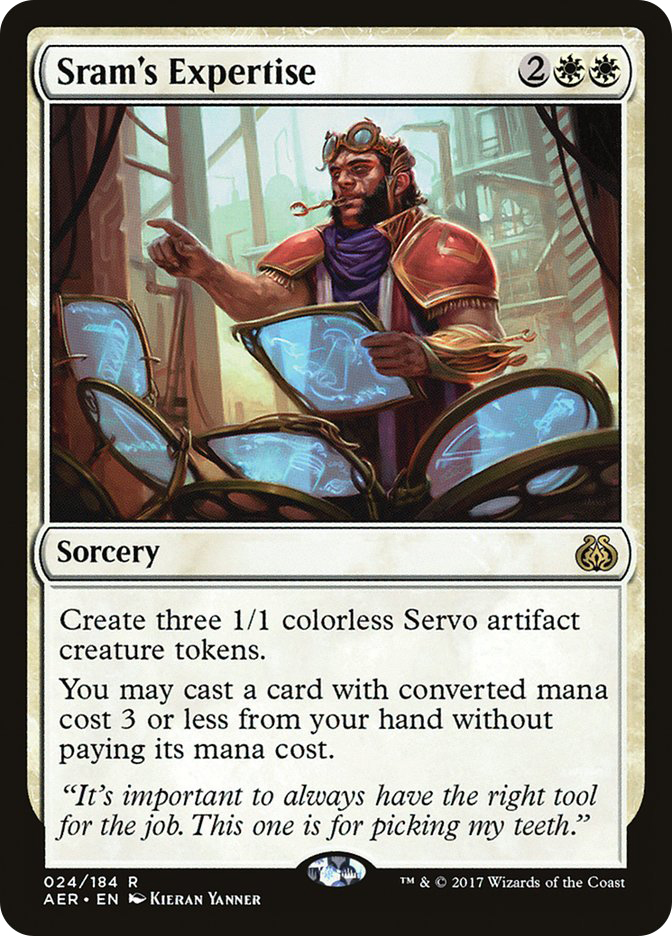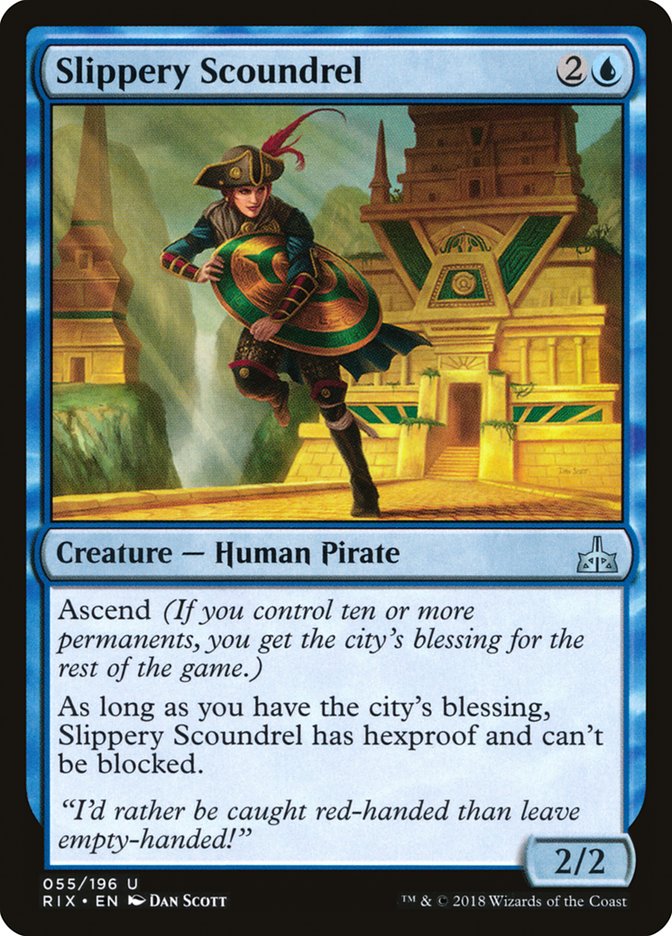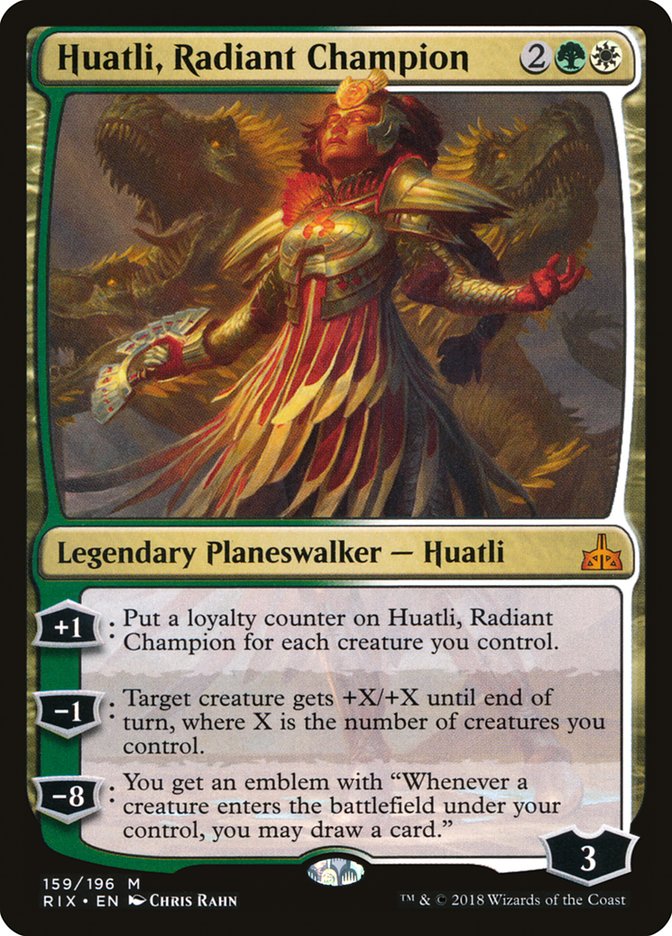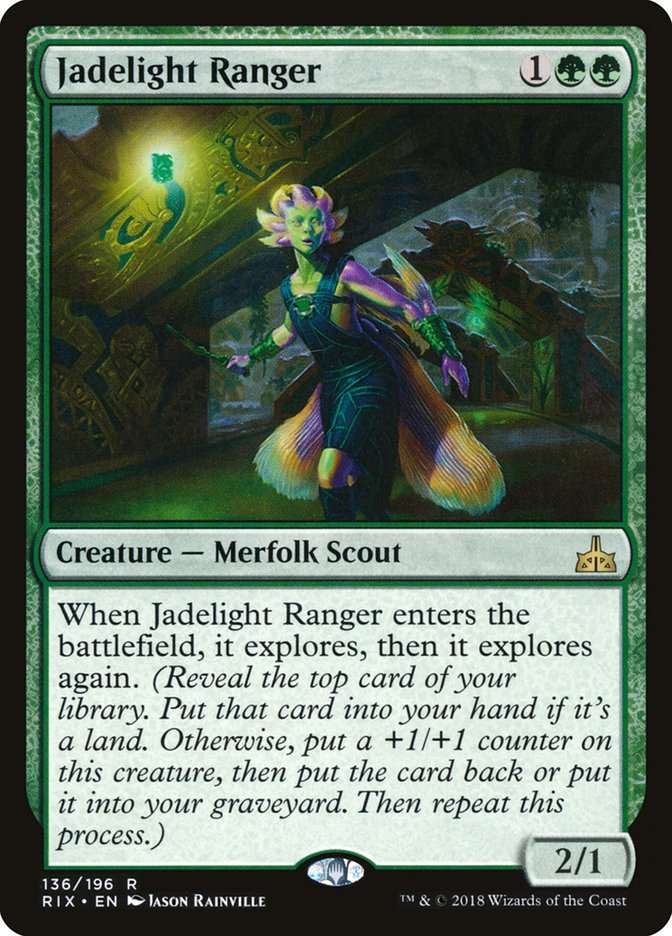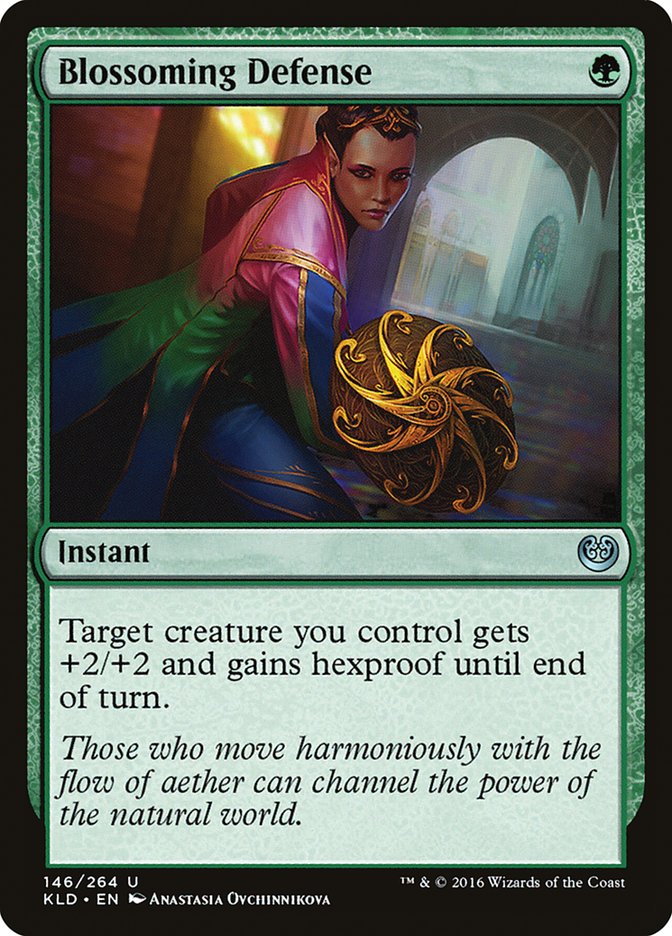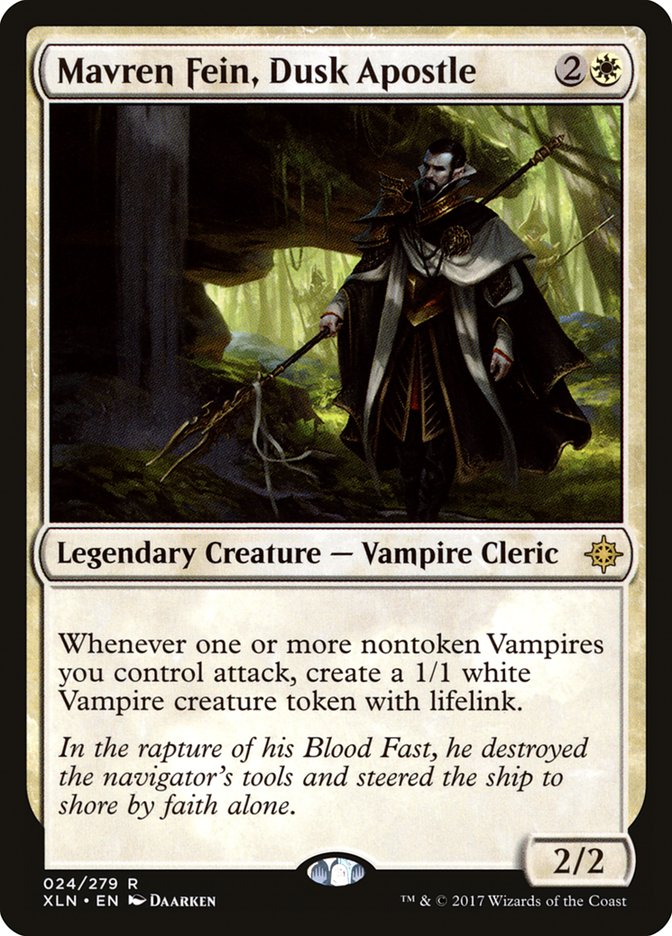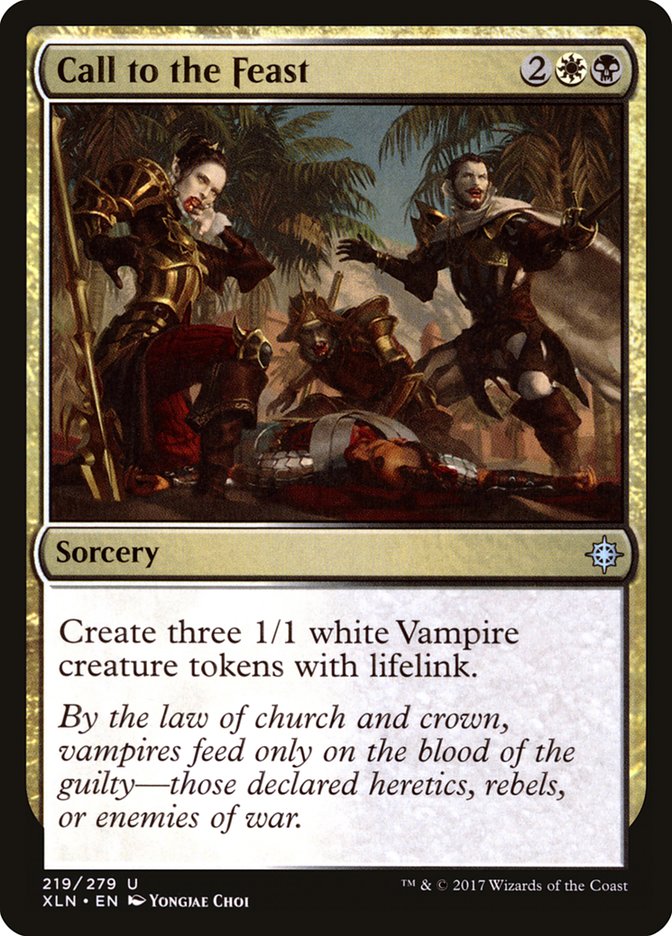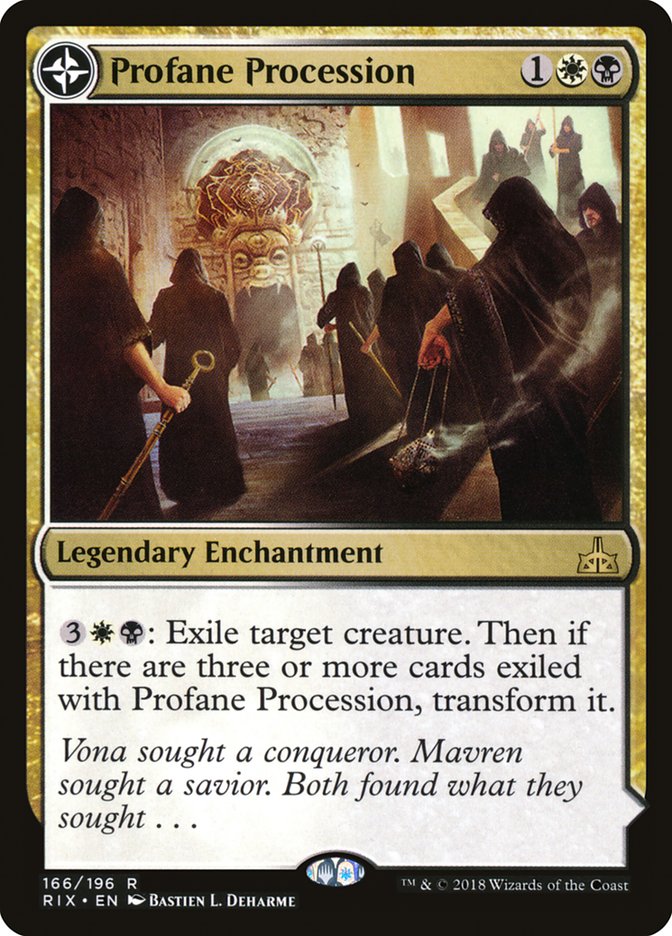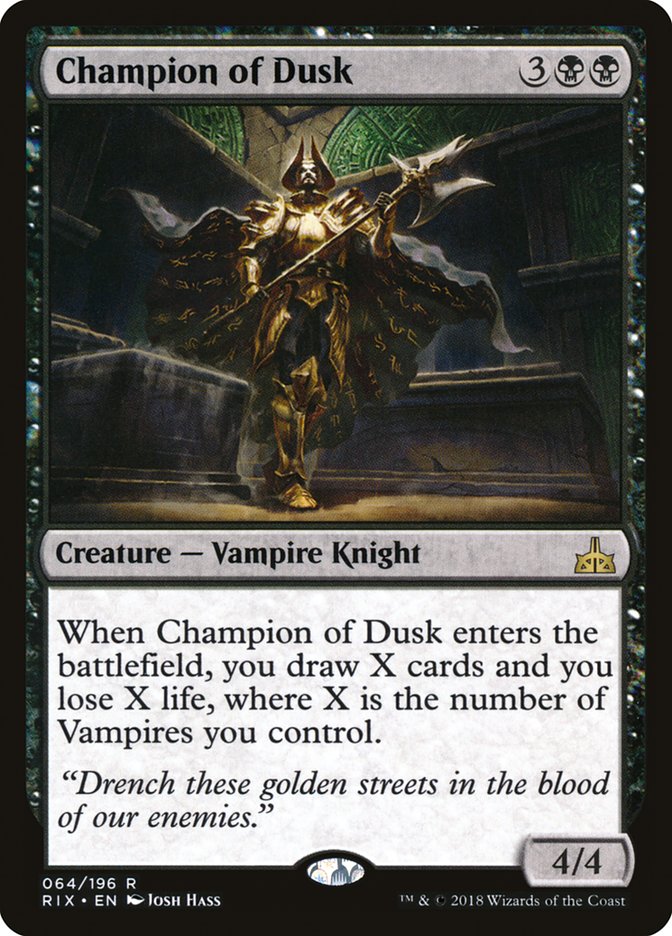Standard has been a battle of the mythic rares as of late. Who wins —
Hazoret the Fervent or The Scarab God? Where do Heart of Kiran, Rekindling
Phoenix, and Torrential Gearhulk fit into the mix?
Well, lately I’ve been playing with a very strange, clearly over-developed
Blade of the Sixth Pride.
It might not have that mythic rare symbol, but Adanto Vanguard has a bunch
of awesome abilities and is the unsung hero of Standard.
White decks in Standard are very good at applying pressure with difficult
to remove threats, either using a go-wide token approach or cards like
Adanto Vanguard, Sacred Cat, Legion’s Landing, and Adorned Pouncer. Shefet
Dunes is the ultimate closer, often setting up one or two turns of alpha
strikes that will typically decimate your opponent’s position.
Many decks in Standard focus on a “Protect the Queen” strategy, hoping to
remove key threats while sticking their own. The Adanto Vanguard decks use
the complete opposite tactic, often flooding the battlefield with creatures
that aren’t worth killing and mostly ignoring what their opponent is doing.
Given how removal-heavy Standard is at the moment, it’s a tactic that
works.
Caution: These decks use the combat phase relentlessly. It may take some
time to get used to when to make a suicidal attack in order to transform
Legion’s Landing, when to give Adanto Vanguard indestructible in tight
racing situations, when to chump block and with what, when to use a
non-lethal Shefet Dunes, and how many creatures to keep on defense against
Mono-Red Aggro’s plethora of ways to mess up combat.
The first decklist is arguably the best of the bunch, despite looking like
a pile of Draft chaff.
Creatures (15)
Lands (22)
Spells (23)
- 4 Sram's Expertise
- 3 Aethersphere Harvester
- 4 Cartouche of Solidarity
- 4 Cartouche of Knowledge
- 4 Legion's Landing
- 4 Curious Obsession
Sideboard

Credit to Jim Davis for the original list and MTGO user Ruiner for the
majority of the innovations.
This version eschews the Sheltering Lights, Skymarcher Aspirants, and
Adorned Pouncers from Jim’s original list for more of a go-wide approach.
You basically harass and frustrate your opponents by making their cards
largely ineffective against you. Despite having a cheap curve, W/U Sram
also scales just fine into the mid to late game thanks to Adanto, the First
Fort, Shefet Dunes, and the various auras.
Sram, Senior Edificer doesn’t live very often, but he’s not integral to
winning. The auras are oddly fine on their own and occasionally insane on
Adanto Vanguard and Slippery Scoundrel. Sram’s Expertise plus Shefet Dunes
is typically the real finisher. However, if Sram does live, you can easily
build a sizable advantage.
The Sram’s Expertise / Slippery Scoundrel innovation is probably what puts
the deck over the top. Both work well together since Sram’s Expertise
likely gets you to ten permanents and then the Scoundrel comes in for free
(and with hexproof). At that point, you are behind a wall of tokens and
ready to suit up a hexproof and unblockable creature. If the early game
doesn’t necessarily go your way, you have a backup plan.
Aethersphere Harvester is another nice touch that allows you to grind a
little better. Red decks usually only have four or less answers to it in
their maindeck, so it living is often a reality. I’ve been considering
adding two Aether Hubs to get that additional lifelink activation, but they
could also be used to fix your mana against decks where lifelink isn’t
relevant.
Squire’s Devotion is typically great, especially on Adanto Vanguard and
Slippery Scoundrel. Red decks typically have no way of cleanly removing
either. Once you have Squire’s Devotion on an Adanto Vanguard, you have a
free way to activate indestructible each combat. Soon, they’ll be in the
abyss. If you have a way to remove Rekindling Phoenix or Hazoret the
Fervent, they don’t have any good ways of dealing with the combo. Authority
of the Consuls tends to trump Rekindling Phoenix also.
Cast Out is my all-purpose answer to The Scarab God, Hazoret the Fervent,
and God-Pharaoh’s Gift. Initially I played Ixalan’s Binding, but you’re not
trying to play a long game. The flexibility of Cast Out, between cycling
and flash, is too good to pass up, especially since these decks often cheat
on lands a little bit.
The only card that matters against decks like Approach and B/G Ramp is
Negate. Past that, you could try things like Revolutionary Rebuff, but it
goes dead quickly. Against something like U/B Control that has a bunch of
creature-based threats, you have to rely on Cast Out. Gideon of the Trials
is another fine threat that doesn’t fall victim to your opponent’s
sweepers.
Another comically underrated deck is W/G Aggro, similar to what Willy Edel
built for Pro Tour Ixalan.
Creatures (20)
Planeswalkers (2)
Lands (24)
Spells (14)

As you can tell, I’m very high on the one-drops, at least the ones that
provide additional value. Many will say the one-drops go dead quickly and
are too low impact because of that. Especially against Mono-Red, I heavily
disagree. When you have Shefet Dunes, Legion’s Landing, and cards like
Huatli, Radiant Champion, every cheap creature you play scales.
This deck is essentially splashing Jadelight Ranger, which is definitely
one of the weakest aspects of the deck. Jadelight Ranger is incredible in
this deck, and if you want to play green, it’s worth it. You might not be
able to cast it on Turn 3 or you might have to sequence your lands
awkwardly, but it’s often the most impactful card you can cast. Getting to
deposit an aftermath or eternalize card into the graveyard can be
game-breaking, as can drawing extra lands or sifting through low impact
cards. It’s telling that I have basically never put Jadelight Ranger into
the graveyard off an explore, no matter how late it is in the game.
I haven’t been impressed with Blossoming Defense. The threat of a combo
kill with Appeal or Huatli, Radiant Champion is threatening, but instead of
trying to protect your big turn, I’d rather forgo it entirely and force
them to keep mana open.
Regal Caracal was in my maindeck for a while because I found myself wanting
something on the top end and it fit the theme. Unfortunately, it failed to
impress in many ways. There is still some space for a big spell maindeck,
but nothing seems quite appropriate. The Oketras that show up in many lists
are likely bad Huatlis. The secret might be fitting a couple Resilient
Khenras back into the deck.
Aethersphere Harvester isn’t typically seen in W/G, but it’s a great
addition. My earlier comments on Aether Hub apply here too, except it’s
probably a slam dunk over Tranquil Expanse. It has evasion, it gains life
which gives you time to assemble a large squad for an alpha strike, and
it’s good against sweepers and planeswalkers.
The sideboard plan here is pretty similar to W/Us, except you attack the
slower decks with planeswalkers instead of counterspells. I like Silent
Gravestone against decks with The Scarab God because of how low the
opportunity cost is. It also helps against God-Pharaoh’s Gift decks,
although note that God-Pharaoh’s Gift doesn’t target! Three copies might be
overkill though.
Adanto Vanguard also happens to be a Vampire, and there’s no shortage of
synergies to explore there.
Creatures (25)
- 3 Angel of Invention
- 4 Aviary Mechanic
- 4 Metallic Mimic
- 3 Mavren Fein, Dusk Apostle
- 4 Legion Conquistador
- 4 Adanto Vanguard
- 3 Skymarcher Aspirant
Lands (22)
Spells (13)

Creatures (26)
- 4 Metallic Mimic
- 4 Mavren Fein, Dusk Apostle
- 2 Duskborne Skymarcher
- 4 Adanto Vanguard
- 4 Paladin of the Bloodstained
- 4 Skymarcher Aspirant
- 4 Martyr of Dusk
Lands (23)
Spells (11)
Sideboard

These lists are cute, but you can see exactly how weak their sideboards
are. I’m down with Oketra’s Monument in theory, but is it actually better
than Radiant Destiny? I’m guessing not, which means I would default to the
aggressive version given the choice.
Still, there is very little reason to be mono-white. The mana isn’t
perfect, but the black upgrades are huge. Trading Sunscorched Desert for
basic Swamp is an upgrade, even if it means you can’t use Shefet Dunes
every turn past Turn 5.
Creatures (21)
- 2 Yahenni, Undying Partisan
- 3 Mavren Fein, Dusk Apostle
- 4 Adanto Vanguard
- 2 Elenda, the Dusk Rose
- 4 Legion Lieutenant
- 4 Dusk Legion Zealot
- 2 Martyr of Dusk
Lands (24)
Spells (15)
Sideboard

The filler aspect of this deck is tough. I’ve chosen to omit Skymarcher
Aspirant, despite the City’s Blessing being relatively easy to obtain.
Jackal Pup into Elvish Visionary highlights some contentious game plans,
and while the flying is relevant, a Jackal Pup doesn’t exactly serve what
this deck is trying to do. That still might not matter all that much
because of the presence of the anthem effects. As I mentioned earlier,
having an additional body on the battlefield scales greatly.
Call to the Feast is surprisingly great. I mean, it shouldn’t be
considering how much Sram’s Expertise I’ve been casting lately, but Sram’s
Expertise has a huge upside when you’re able to cast an Aethersphere
Harvester or some such off it for free. The fact that you have twelve
anthems for Vampires puts Call to the Feast over the top.
One of the best answers to a bunch of Rekindling Phoenixes and Hazorets is
Profane Procession, especially since you have the aggressive aspects of the
red decks covered with your Vampire tokens. Whereas W/U and W/G can
struggle with a Rekindling Phoenix to some degree, W/B has it covered with
a plethora of viable options. Playing Profane Procession maindeck for some
late game staying power isn’t the craziest thing.
Aethersphere Harvester has been a mainstay in basically all of my white
decks, but it’s absent here. Simply put, you don’t need it. It doesn’t
serve any specific role that your deck can’t accomplish otherwise. You have
all the lifegain and staying power you could possibly want in Vampires, so
there’s no need for a card that detracts from the synergies.
One of the cards I want to try is Champion of Dusk, but it’s likely some
combination of win-more and too slow. Five mana is a big ask, especially
for a deck that’s somewhat light on lands and has several that enter the
battlefield tapped. I could see it being a game breaker in midrange or
control matchups, but it might also be really bad if they cast a sweeper
against you. Given that, it seems like more of a maindeck card, but it’s
not something you’d want against Mono-Red, so that probably disqualifies
it. This deck is also quite good without it, so it’s not like it’s a
necessity or anything.
Another option that exists if white aggro decks are prevalent is
sideboarding some Golden Demises. They can go dead quickly in the face of a
Radiant Destiny, but you have some removal for those.
The sideboard plan is basically the same – Remove the creatures that die to
Abrade and Shock without value, such as Mavren Fein, Dusk Apostle, and add
in some staying power and removal for their four-drops. Legion Lieutenant
is often fine as a two-drop, plus if you catch them tapped out it can be
punishing.
***
If you’re at all worried about the Adanto Vanguard decks out there, there
are things you can improve without weakening your deck against the rest of
the field. A second Golden Demise in your sideboard, an additional way to
interact with artifacts and enchantments, or some Sweltering Suns will go a
long way.
My first foray into this Standard was playing all sorts of R/B decks, from
midrange to aggro. One of the constants was how poorly my Chandras and spot
removal lined up against white decks. Field of Ruin was important for
shutting down Adanto, the First Fort and Shefet Dunes, but my best shot was
using sweepers to contain them (even if just for a couple turns) and
clocking them with a big flyer.
If I were playing Standard this weekend, I could see playing U/B Control or
R/B Aggro, but realistically I’d be attacking for three. As always, being
proactive is a better game plan.


